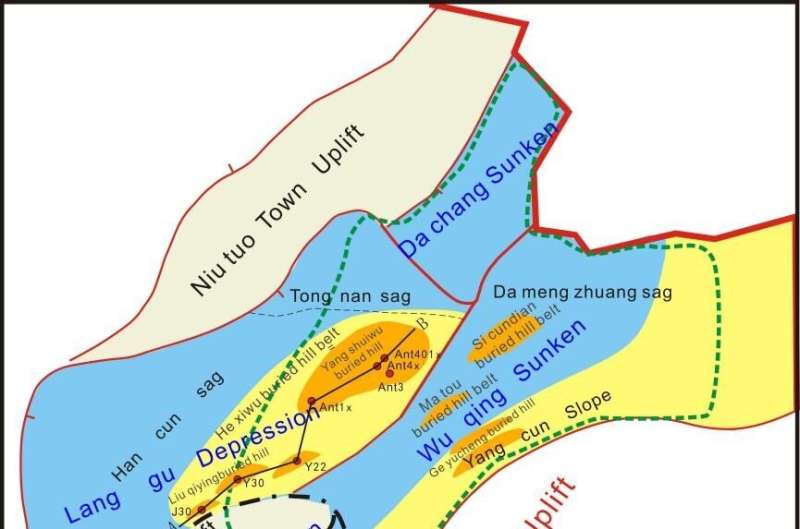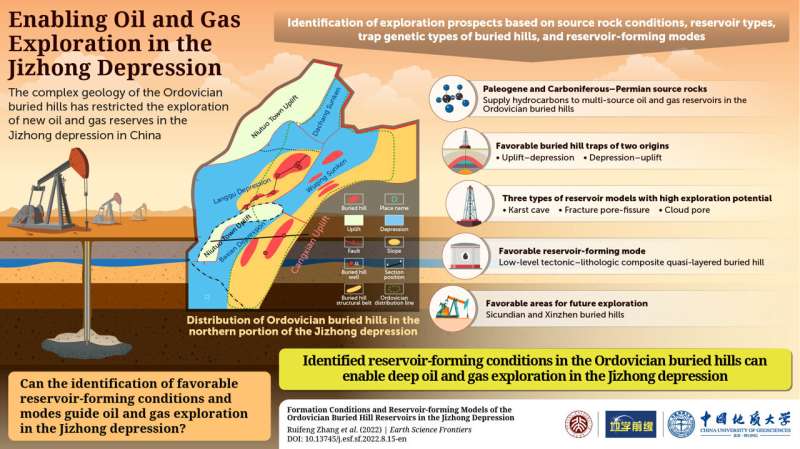New study cracks the code for future exploration of oil and gas in the Jizhong depression

Oil and gas are two of the most important natural resources, contributing to over half of the world's energy supply. Reserves of these resources are thus, of high economic and strategic interest.
The Jizhong depression of the Bohai Bay Basin in China is home to multiple buried hills, i.e., elevations on old land surfaces which are now covered by younger sedimentary rocks. These hills are abundant in oil and gas reserves and have optimal oil and gas accumulation conditions.
The Ordovician buried hills in particular, have been extensively explored since 1977. Unfortunately, further exploration in this region is difficult due to the exhaustion of high-amplitude and easily identifiable medium–shallow buried hills. The complex geology and reservoir heterogeneity of the Ordovician buried hills has added to this challenge in exploration.
To enable further unrestricted exploration of this region, a team of researchers led by Professor Ruifeng Zhang from the PetroChina Huabei Oilfield Company conducted a study, which was published in Earth Science Frontiers, to analyze the reservoir-forming conditions and modes in the Ordovician buried hills, including the source rock conditions, reservoir types, and trap genetic types. "Our analysis was largely derived from a large volume of logging, core, thin section, seismic, and geochemical data," says Prof. Zhang while discussing the study.
Prof. Zhang and his team discovered that three sets of source rocks from the Carboniferous-Permian and Paleogene geologic periods developed in the Jizhong depression. Notably, these rocks provide adequate quantities of important materials such as hydrocarbons required for the formation of oil and gas reserves in the Ordovician buried hills.
In addition, they clarified the mechanism of reservoir control and identified three types of reservoir models with high exploration potential. These included the Karst cave, fracture-fissure pore, and cloud pore.
On further analysis, the team also identified the two most favorable buried hill genetic traps, namely, uplift–depression and depression–uplift, which were formed as a result of the Indosinian, Yanshanian, and Himalayan tectonic processes in the Ordovician buried hills.

Three oil and gas reservoir-forming modes, which include the low-level tectonic–lithologic composite quasi-layered buried hill, medium-level paleo-storage paleo-block buried hill, and the high-level paleo-storage new-block buried hill were identified in this region. Of these, the reservoir forming conditions of the low-level tectonic-lithologic composite quasi-layered buried hill is considered as the most favorable for further exploration at present.
Importantly, the team identified the most favorable areas for further exploration as the Sicundian and Xinzhen buried hills.
"Exploring the newly identified reservoir-forming conditions and modes in the Jizhong depression will allow unhindered oil and gas exploration to continue, which is essential to avoid the depletion of energy resources in the coming years," says Prof. Zhang.
More information: Formation conditions and reservoir-forming models of the Ordovician buried hill reservoirs in the Jizhong depression, Earth Science Frontiers (2022). DOI: 10.13745/j.esf.sf.2022.8.15-en
Provided by Cactus Communications



















